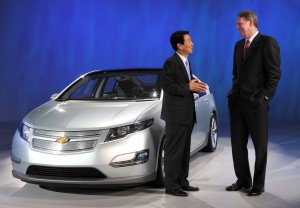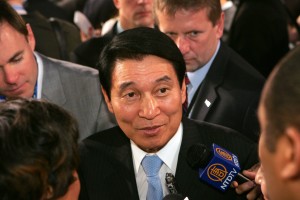
LG Chem President and CEO Kim Bahn-suk (left) meets with GM Chairman Rick Wagoner.
General Motors made headlines, earlier this year, when it announced it had chosen the South Korean manufacturer LG Chem to provide the batteries needed to power the eagerly-awaited Chevrolet Volt. That plug-in hybrid, or extended-range electric vehicle, as GM prefers to call it, could revolutionize the auto industry, since it will allow a typical American to commute without using a drop of gasoline, but still have the ability to drive longer distances without long waits needed to charge Volt’s batteries.
Equally significant, at least at first blush, was the news that GM will set up a new battery plant to put together the T-shaped packs used in the Volt. But that second announcement was misleading — intentionally or otherwise. The facility the automaker is building will not produce the actual battery cells. Those will be made in Korea, a country that severely restricts U.S. imports, and then shipped to the U.S. for final assembly.
In automotive terms, a fair comparison can be made to the classic CKD plants companies like GM, Mercedes-Benz or Toyota have long operated in marginal, third-world markets that require “local” production. Everything of substance is actually made elsewhere, the parts then shipped to a CKD final assembly line for the finishing touches. One CKD scam is to remove the wheels or radio and leave those simple tasks to local labor. Another analogy would compare what GM has in mind to the plastic car models millions of Americans build. Simply pop off the parts and glue them together.
Why does this matter? Because the truly valuable part of battery manufacturing — including the core intellectual property — belongs to off-shore manufacturers, such as LG Chem. Unless this approach is changed, it could be argued, the U.S. would be as vulnerable as it is today, with its dependence on imported oil — perhaps even more vulnerable. There’s at least the potential to produce bio-fuels here in the U.S. and pump petroleum from domestic sources. But no president since Jimmy Carter has devoted, well, any energy to a national energy policy. It remains to be seen if the Obama administration comes up with a viable one.

LG Chem CEO Kim Bahn-suk is swarmed by the media after the GM off-shore sourcing decision.
Right now without off-shore made batteries, there would be far fewer electric vehicles. There would be virtually no cell phones, laptop computers, PSPs, or, well, the list goes on. That’s not just a concern for consumers, but for the Department of Defense. The military is highly dependent on battery technology for its satellites and smart bombs and, in the future, for all sorts of vehicles and weapons that will be using electric power. And of course we spend mind-boggling amounts of taxpayer money in the Defense budget, to say nothing of and soldiers blood to keep the oil trade going in unstable regions.
At the moment, there is but a single plant in the entire United States capable of producing the most advanced battery technology on the market, the Lithium-Ion cell. The Indianapolis facility couldn’t dream of filling the need for the entire U.S. market, even today, never mind tomorrow, when some proponents believe a large portion of our automotive fleet will be “electrified.”
Setting up more battery plants won’t be easy. The necessary manufacturing facilities are as complex as those used to produce silicon computer chips, and just as expensive, typically a billion dollars or more.
Meanwhile, the science of battery chemistry is evolving fast, and much of the brainpower is based overseas, primarily in Japan, Korea and China. The latter country is the emerging leader, and battery power is seen, there, as a way to resolve the country’s endemic air pollution problems.
That’s not to say America can’t compete, especially on a scientific level. There is an assortment of high-tech companies, many of them start-ups, advancing the science of Lithium ion chemistry, as well as exploring exotic new forms of batteries, from sodium-sulfur to vanadium slush. But there has been an unfortunate history of watching as developments here in the U.S. are transferred abroad, with the final products shipped back from off-shore plants. There is also the very real issue of using taxpayer money to finance university research and then allowing those researchers to form corporations and make profits while the taxpayers get nothing.
With an infusion of more than $2 billion in grants from the Department of Energy, President Barack Obama hopes to power up the American battery industry — and with it the electric vehicle market. The money he announced during a visit to a California Edison EV test center, on Thursday, is critical to the U.S. The vast majority of that grant fund will be dedicated to the development of batteries and battery manufacturing operations. Let’s hope that unlike so many other government programs, this one is managed well and taxpayers fronting the money share in the gains.
We have the potential for greatness in the field. There are numerous research centers, both government and private, that could support an American battery manufacturing effort. The University of Michigan, in fact, has trained many of the best scientists working off-shore. And, to its credit, GM, in January, also announced plans to provide significant funding for the U of M battery program.
America must move fast or risk being left behind. Even as President Obama pumps money into battery development, our rivals, allies and enemies alike, are also targeting what could become the strategic resource of OPEC proportions in the 21st Century and beyond.

Paul
Don’t know where your billion-dollar cost for a cell plant came from. The figures I’m hearing are more like $300 million for the first ones, less for subsequent iterations.
Hi, John,
I have, to be honest, heard numbers all over the map, but several industry senior execs have been quoting the billion-dollar figure in interviews. I think it’s time to pursue this a little further.
Paul A. Eisenstein
Bureau Chief, TheDetroitBureau.com
Whether we lead or follow it’s clear we have to get into the battery game in a serious and committed way. The Department of Energy needs to refocus its energy away from nuclear weapons and nuclear power which, according to researchers, consumes approximately $27-billion a year, or two-thirds of DOE’s budget. We need to tell the new Secretary of Energy, Steven Chu, that it’s batteries we need and not more nifty missiles that we’ll store in silos. Unless, they’re battery powered, of course.
By Bob Kruse
Global Hybrid, Electric Vehicle and Battery Engineering Executive Director
Our recent announcement that GM would produce the battery modules and packs for the Chevrolet Volt has created a lot of excitement. And it should. Our facility will be the first lithium-ion battery manufacturing plant operated by a major automaker in the U.S., and will create new “green” jobs.
The Volt’s batteries will use cells sourced from LG Chem, which is based in South Korea. And that has led to the inaccurate perception the Volt’s battery development is being led outside the U.S. – so let me clear up any confusion.
The Volt’s battery design, development and vehicle integration is and will continue to be done right here in the U.S., in Michigan.
Now, battery cells undoubtedly are the basis of any battery, but they don’t guarantee a first-class, finished product. Look at it this way: a well-poured concrete foundation for a new home is important, but it doesn’t automatically mean the finished house will meet the owner’s expectations. You need the expertise of architects, electricians, plumbers and carpenters to finish the job.
That is GM’s role in the Volt’s battery value chain.
We write the software and produce the electronic controls that operate the battery. We design the battery pack. We integrate the battery into the vehicle. We design the vehicle, and maximize the battery’s capabilities to meet the Volt’s unique performance expectations, such as up to 40 miles of electric-only driving.
With more than 15 years of advanced battery development experience and an extensive powertrain controls strategy, GM arguably has industry leading expertise in this area. And we continue to add to our resources, with the largest automotive battery lab in the U.S. We’ll officially open the facility this spring.
Controlling the entire battery development process, from individual cell management to vehicle integration is unique in the auto industry and gives GM a competitive advantage. How? It improves vehicle integration and safety, and provides flexibility to quickly adapt to other chemistries or cells should they come along in the future.
(Washington D.C.)- Rep. Sander Levin(D Michigan) issued the following statement regarding the announcement by President Obama that the Department of Energy will make available $2.4 billion in grant funding to support advanced battery manufacturing, electric vehicle and component manufacturing, and vehicle electrification demonstration projects.
“President Obama’s announcement that the Department of Energy will make $2.4 billion in grant funding available for advanced battery manufacturing and vehicle electrification is a welcome and needed step toward the revitalization of the domestic auto industry. This is exactly the kind of federal partnership that is necessary for the domestic auto industry as it continues working to produce the cars of the future, including plug-in hybrids and electric vehicles.”
“Advanced battery manufacturing is a critical gap in America’s industrial base, and one we must close. The domestic auto industry is committed to producing electric vehicles that will reduce emissions and help end our dependence on foreign oil. But we cannot trade our dependence on foreign oil for a dependence on foreign batteries. The President’s announcement today starts us on a path to ensuring that the vehicles of tomorrow, and the batteries that power them, are produced right here in the US.”